Films & Performances
––––––––––––––––



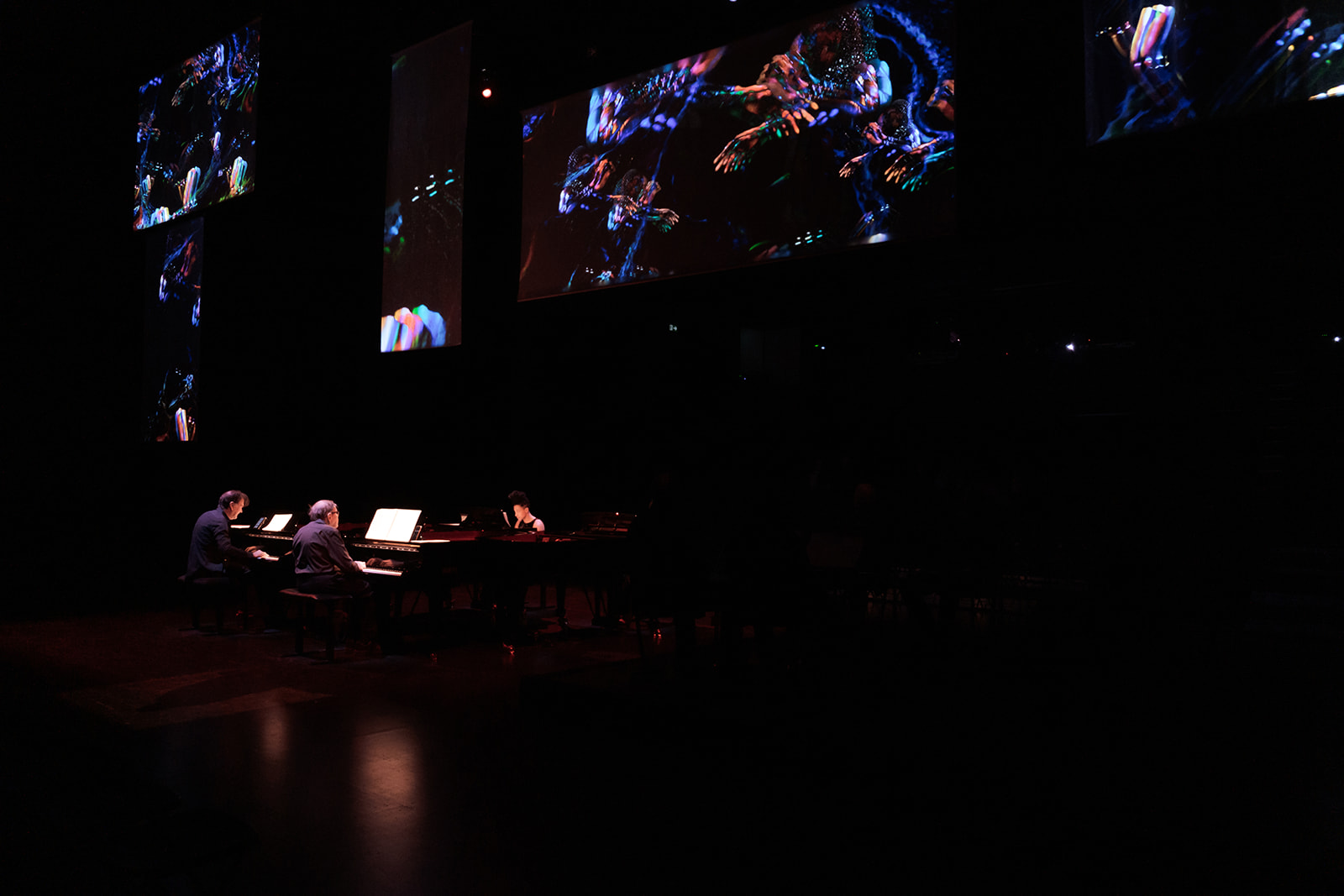



Evil N, 2024
Five-channels video installation, 22mns
Film Direction, Editing and Performance.
–– Part of “Joy Boy, a Tribute to Julius Eastman” film series and live concert
–– Venues: DeSingel (Antwerp, 2024), Netwerk Aalst (2025)
Six filmmakers enter into conversation around the transcendent music, queer activism, and vibrant spirituality of African American composer, performer, and activist Julius Eastman (1940–1990). Originally a classically trained pianist, Eastman became a central figure in New York’s experimental music scene in the late 1970s, collaborating with artists such as Meredith Monk and Pauline Oliveros. Yet he died in precarity in 1990. His music — which he described as ‘organic’ — was known for its slow, cumulative structure, often bearing politically charged titles such as Evil Nigger, Gay Guerrilla, or Joy Boy, marking both a radical compositional stance and an uncompromising political gesture. As a Black queer man navigating the structural erasures of both classical and avant-garde music, Eastman used sound to carve out a future where dignity meets resistance, leaving behind a powerful yet shadowed legacy.
In ‘‘Joy Boy, a Tribute to Julius Eastman’’, that legacy is reactivated across a constellation of interconnected filmic, sonic, and choreographic gestures. A series of video pieces and audio interludes — projected alongside live performances by four pianists, four wind players, and two singers — formed the basis of a live commission. In its latest iteration, the project unfolds as a multidimensional installation, incorporating new physical artworks that translate Eastman’s score into fabric and material texture. By carrying the work beyond the stage, Joy Boy expands Eastman’s invitational liveness into new spatial and sensory registers. It traces the political and spiritual resonance of his minimalism, foregrounding its capacity to generate not only aesthetic experience, but gestures of healing, resistance, and speculative reparation.
Credits:
–– Films:
Evil N - by Mawena Yehouessi & Fallon Mayanja
Many, Many Women - by Rob Jacobs
Gay Guerrilla - by Anne Reijniers & Paul Shemisi, with Sanders Coccinelle, Naomie Kulemfuka, Dan Monga and Thony Yondo
Joy Boy - by Victoire Karera Kampire, with Alfi Lola Mulamba
–– Music:
scores by Julius Eastman, Petr Kotik; performed by Petr Kotik & the S.E.M Ensemble, Joe Kubera, Arturo den Hertog, Djuwa Mroivili, Esther-Elisabeth Rispens, Emi See, Daan Vandewall
–– Visual Art:
Benjamin Mengistu Navet
–– Sceno, tech & coordination:
Ferenc Balcaen, Annik Laruelle, Anne Van Es
–– Production:
DeSingel, Music Theatre Transparant, Netwerk Aalst
–– Films:
Evil N - by Mawena Yehouessi & Fallon Mayanja
Many, Many Women - by Rob Jacobs
Gay Guerrilla - by Anne Reijniers & Paul Shemisi, with Sanders Coccinelle, Naomie Kulemfuka, Dan Monga and Thony Yondo
Joy Boy - by Victoire Karera Kampire, with Alfi Lola Mulamba
–– Music:
scores by Julius Eastman, Petr Kotik; performed by Petr Kotik & the S.E.M Ensemble, Joe Kubera, Arturo den Hertog, Djuwa Mroivili, Esther-Elisabeth Rispens, Emi See, Daan Vandewall
–– Visual Art:
Benjamin Mengistu Navet
–– Sceno, tech & coordination:
Ferenc Balcaen, Annik Laruelle, Anne Van Es
–– Production:
DeSingel, Music Theatre Transparant, Netwerk Aalst
––––––––––––––––
![]()
![]()
![]()
![]()
![]()
![]()
![]()
![]()
![]()
![]()
![]()
![]()
![]()
![]()
![]()
![]()
![]()
![]()
Credits:
–– Images:
Paola Delfino, Josèfa Ntjam, Nicolas Pirus, Seumboy Vrainom :€, Mawena Yehouessi, Internet
–– Music:
Ibaaku, Christelle Oyiri (aka Crystallmess), Harilay Rabenjamina, Eden Tinto-Collins, Elie Rivière (aka Shien Nera)
–– Texts:
D.Sey (aka Seydou), Nour Hsissou, Ibrahim Meité, Elsa Vallot, Mawena Yehouessi
–– Actors & Voices:
Soraya Abdellaoui, Jessika Avomo Nnomo, Moaamed Bamba, Paola Delfino, Trinidad Enzema Momdjoa, Kourouma Famansa, Marie-Alysse Giraud, Mamady Keita, Nadir Khanfour, Bah Mamadou Djan, Laëtitia Marie, Savanah Noel, Aminata Labor, Carlota Sandoval Lizarralde, Julie Scemama, Yanis Sibart, Attandi Trawalley, Nicole de Souza Yehouessi, Tinhinane Zeraoui, Mawena Yehouessi
–– Other Collaborators:
AGM FACTORY, Flo-Souad Benaddi (aka FSB Press), Neïla Czermak Ichti, Isis Dunya, Karima El Karmoudi, Enami, Claire Finch, Hayoung Kim, Kyo Kim, Sonia Labrin, Youen Marivain, Léa Morin, Sarah Netter, collectif NODE, Leïla Nour Johnson, Nicolas Pirus, Noémie Pirus-Hassid, Anne Swaenepoël, Silina Syan, Damien Tronchot, Tantine de Paris, TSM2, Yann Van der Meer, Liz Young
–– Sponsors:
Ateliers Médicis, DICREAM (CNC), Drac Provence-Alpes-Côte d'Azur, La Scam / La Culture avec la Copie Privée, TV Rennes / Agglomération Rennes-Métropole, Villa Arson / Univ. Côte d’Azur
–– Production:
Mawena Yehouessi, SPECTRE (Olivier Marboeuf)
––––––––––––––––
![]()
![]()
![]()
![]()
![]()
![]()
![]()
––––––––––––––––
![]()
![]()
![]()
![]()
![]()
![]()

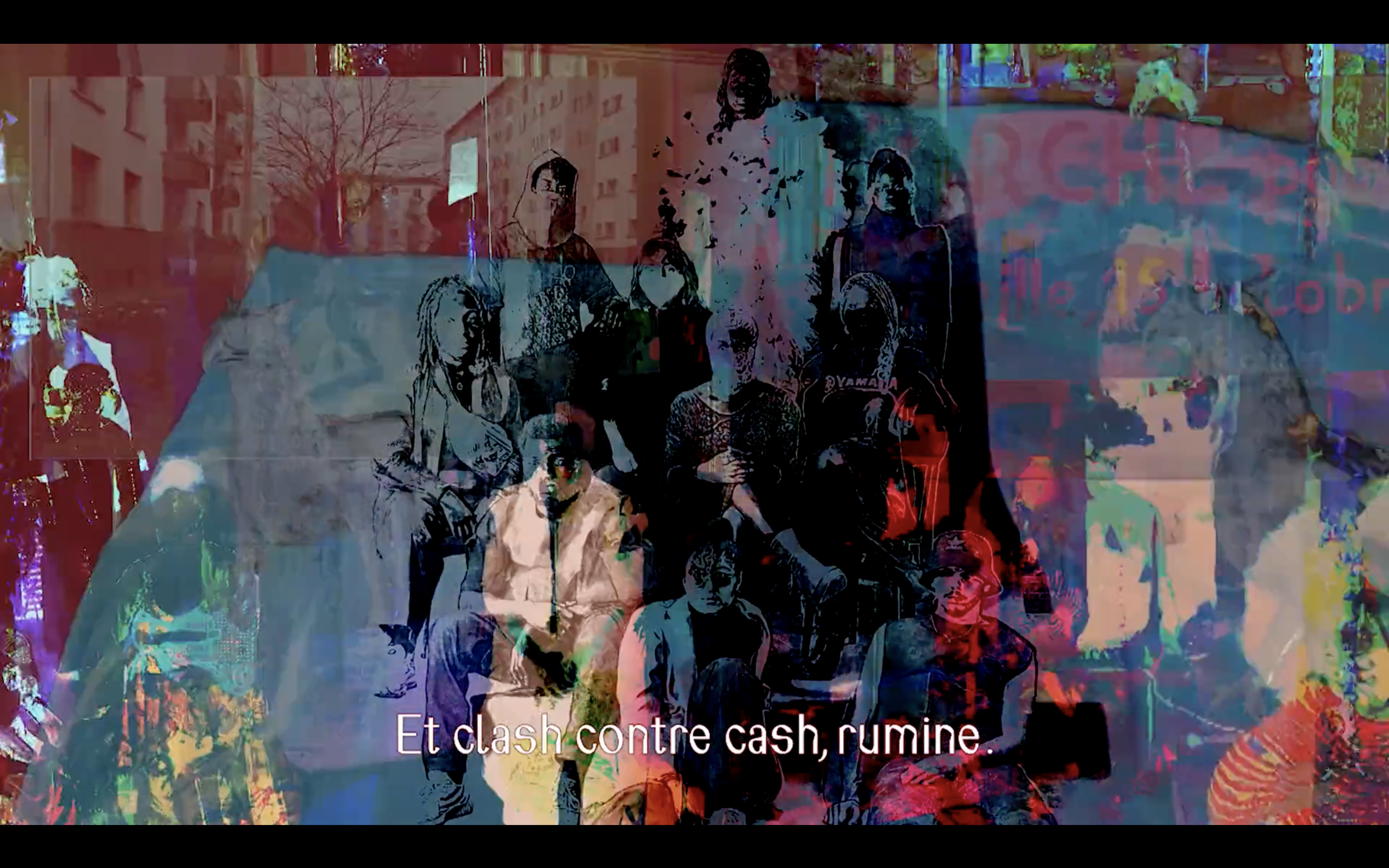

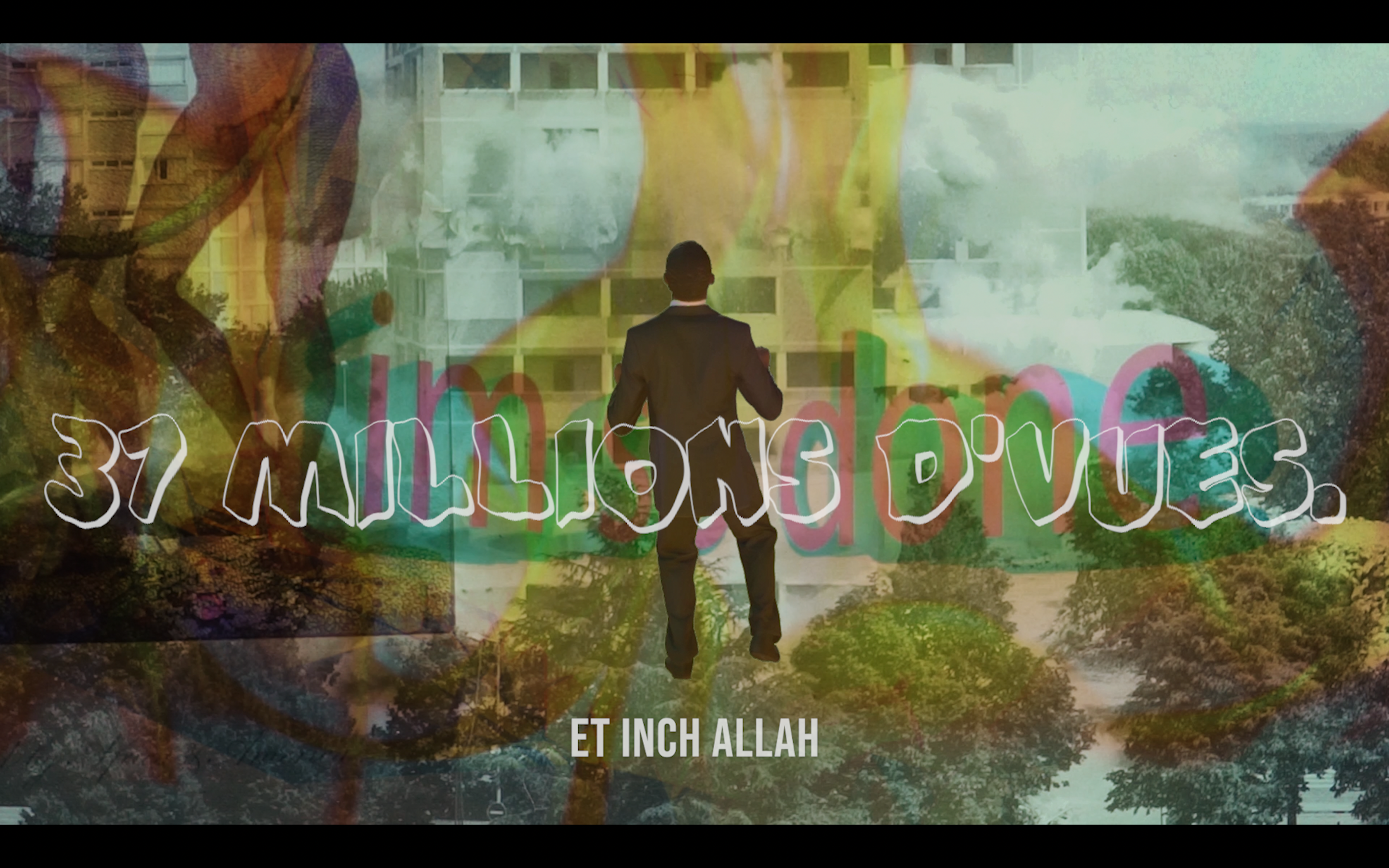









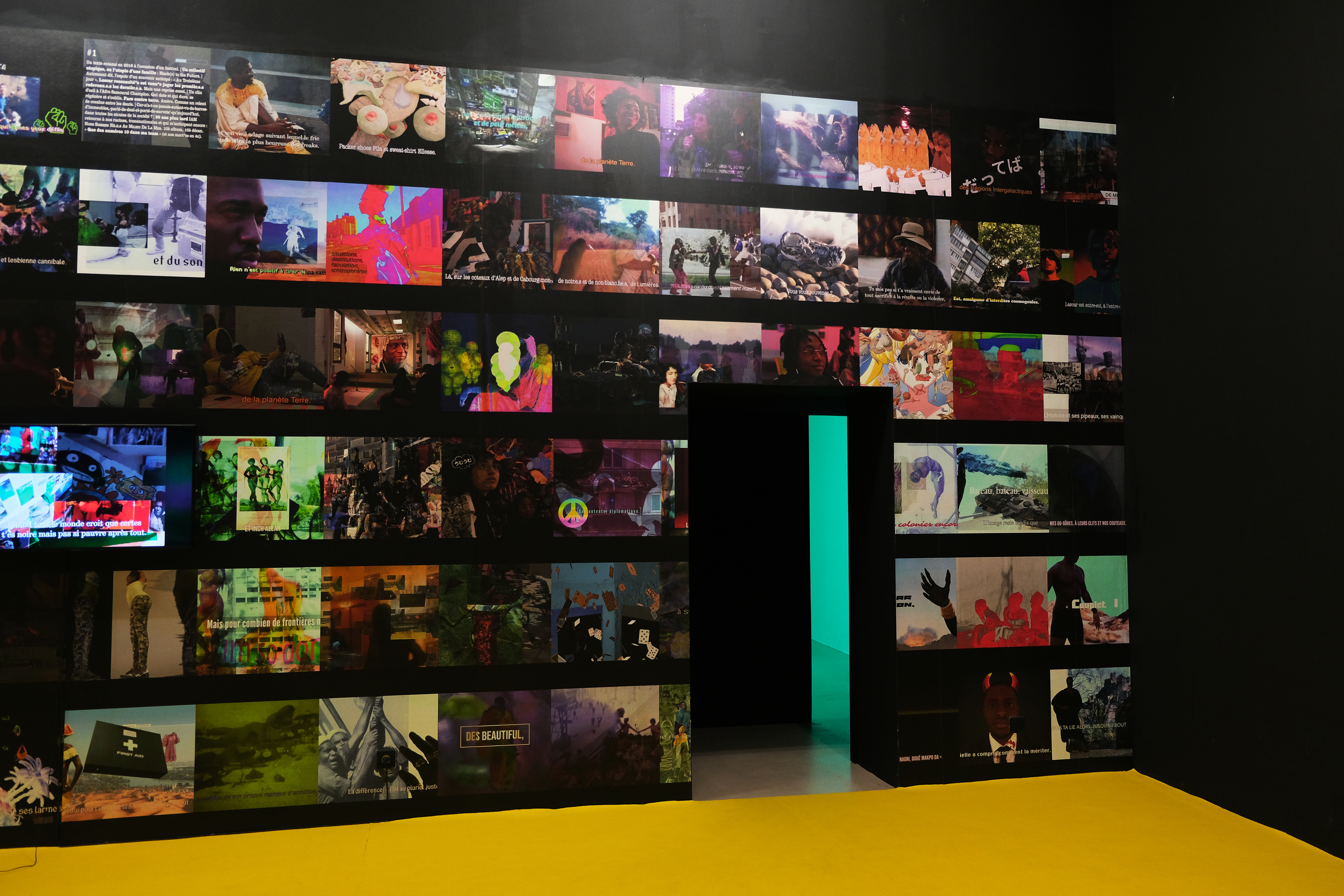

Sol in the Dark, 2022
Single-channel video, 52mns / Full series version (5 eps), 1h20mns
Film Direction, Editing and Production.
Single-channel video, 52mns / Full series version (5 eps), 1h20mns
Film Direction, Editing and Production.
–– Acquired by IAC—Villeurbanne/Rhône-Alpes (French Public Collection, 2024) and Centre National des Arts Plastiques (CNAP / French Public Collection, 2025)
–– Screenings: Berlinale (Berlin), La Villette (Paris), Millennium Docs (Varsovie), ECRÃ (Rio de Janeiro), Festival Silhouette (Paris), Prismatic Ground (New York), FLiMM (Paris), Paraponera Festival (Geneva), SISSI Club (Marseille), Videodrome 2 (Marseille), Triangle France (Marseille), Beursschouwburg (Brussels), Centre Georges Pompidou (Paris), Forum des Images (Paris), FIFAM (Amiens) and more
–– Distribution: Arsenal—Institute for Film and Video Art (Berlin), Collectif Jeune Cinéma (Paris)
Sol in the Dark is an experimental (series of) film(s) rooted at the crossroads of mainstream and experimental cinematic forms, Black studies and the concept of “poïethics”. Commited to decentring hegemonic epistemologies through speculative, situated forms: it premiered at Berlinale 72, in the Forum / Forum Expanded section. It is also a curatorial experiment that exceeds exhibition-making, and a poetical and political inquiry into the process of filmmaking (beyond the viewing itself) as a community gathering device. It explores the permeability between aesthetical representation and ethical “right to opacity” (Glissant), and develops a practice of collage as a mode of care — for fragmented, discarded, or deliberately erased narratives.
The work is anchored in the figure of Lascar; a term derived from the Persian word for “army” and notably used in the 19th century to designate South and Southeast Asian sailors enlisted by European colonial navies. In 1990s France however, it became a popular derogatory label for second- and third-generation BIPOC youth from the suburbs. As such, Lascar appears as both the epicene symbol and symptom of ghosted lineages and an ambivalent role-model for those navigating the margins of artistic, academic, and institutional spaces. Spawning through post-Internet memes and afrofuturist movie stills (including a pastiche of Space is the Place by Sun Ra and John Coney, 1974), national television footage, personal archives and philosophical quotes: the film triggers fugitive modes of narration, portraiture, and co(n)generation — inciting the viewers to reclaim its collage methodology.
Rather than a singular work, Sol in the Dark unfolds as a constellation of formats: a 52-minute hybrid film; a five episode webseries; an immersive installation (inc. monumental wallpapers and a lenticular diptych); and a participatory web interface and evolving online archive used in the context of youth workshops. Each iteration activates a different medium to ask how Blackness, fugitivity and collective acknowledgement might exceed both scientific forecasting containment and cinematic archival capture. As an alter-futurist manifesto, it proposes not a monolithic monument or memorial but a polyphonic memory — a multi-layered yet generative apparatus for rethinking co-creation beyond academic and disciplinary boundaries. Hence, it has gathered over fifty collaborators, challenging dominant logics of authorship and knowledge production.
Sol in the Dark is an experimental (series of) film(s) rooted at the crossroads of mainstream and experimental cinematic forms, Black studies and the concept of “poïethics”. Commited to decentring hegemonic epistemologies through speculative, situated forms: it premiered at Berlinale 72, in the Forum / Forum Expanded section. It is also a curatorial experiment that exceeds exhibition-making, and a poetical and political inquiry into the process of filmmaking (beyond the viewing itself) as a community gathering device. It explores the permeability between aesthetical representation and ethical “right to opacity” (Glissant), and develops a practice of collage as a mode of care — for fragmented, discarded, or deliberately erased narratives.
The work is anchored in the figure of Lascar; a term derived from the Persian word for “army” and notably used in the 19th century to designate South and Southeast Asian sailors enlisted by European colonial navies. In 1990s France however, it became a popular derogatory label for second- and third-generation BIPOC youth from the suburbs. As such, Lascar appears as both the epicene symbol and symptom of ghosted lineages and an ambivalent role-model for those navigating the margins of artistic, academic, and institutional spaces. Spawning through post-Internet memes and afrofuturist movie stills (including a pastiche of Space is the Place by Sun Ra and John Coney, 1974), national television footage, personal archives and philosophical quotes: the film triggers fugitive modes of narration, portraiture, and co(n)generation — inciting the viewers to reclaim its collage methodology.
Rather than a singular work, Sol in the Dark unfolds as a constellation of formats: a 52-minute hybrid film; a five episode webseries; an immersive installation (inc. monumental wallpapers and a lenticular diptych); and a participatory web interface and evolving online archive used in the context of youth workshops. Each iteration activates a different medium to ask how Blackness, fugitivity and collective acknowledgement might exceed both scientific forecasting containment and cinematic archival capture. As an alter-futurist manifesto, it proposes not a monolithic monument or memorial but a polyphonic memory — a multi-layered yet generative apparatus for rethinking co-creation beyond academic and disciplinary boundaries. Hence, it has gathered over fifty collaborators, challenging dominant logics of authorship and knowledge production.
Credits:
–– Images:
Paola Delfino, Josèfa Ntjam, Nicolas Pirus, Seumboy Vrainom :€, Mawena Yehouessi, Internet
–– Music:
Ibaaku, Christelle Oyiri (aka Crystallmess), Harilay Rabenjamina, Eden Tinto-Collins, Elie Rivière (aka Shien Nera)
–– Texts:
D.Sey (aka Seydou), Nour Hsissou, Ibrahim Meité, Elsa Vallot, Mawena Yehouessi
–– Actors & Voices:
Soraya Abdellaoui, Jessika Avomo Nnomo, Moaamed Bamba, Paola Delfino, Trinidad Enzema Momdjoa, Kourouma Famansa, Marie-Alysse Giraud, Mamady Keita, Nadir Khanfour, Bah Mamadou Djan, Laëtitia Marie, Savanah Noel, Aminata Labor, Carlota Sandoval Lizarralde, Julie Scemama, Yanis Sibart, Attandi Trawalley, Nicole de Souza Yehouessi, Tinhinane Zeraoui, Mawena Yehouessi
–– Other Collaborators:
AGM FACTORY, Flo-Souad Benaddi (aka FSB Press), Neïla Czermak Ichti, Isis Dunya, Karima El Karmoudi, Enami, Claire Finch, Hayoung Kim, Kyo Kim, Sonia Labrin, Youen Marivain, Léa Morin, Sarah Netter, collectif NODE, Leïla Nour Johnson, Nicolas Pirus, Noémie Pirus-Hassid, Anne Swaenepoël, Silina Syan, Damien Tronchot, Tantine de Paris, TSM2, Yann Van der Meer, Liz Young
–– Sponsors:
Ateliers Médicis, DICREAM (CNC), Drac Provence-Alpes-Côte d'Azur, La Scam / La Culture avec la Copie Privée, TV Rennes / Agglomération Rennes-Métropole, Villa Arson / Univ. Côte d’Azur
–– Production:
Mawena Yehouessi, SPECTRE (Olivier Marboeuf)
––––––––––––––––
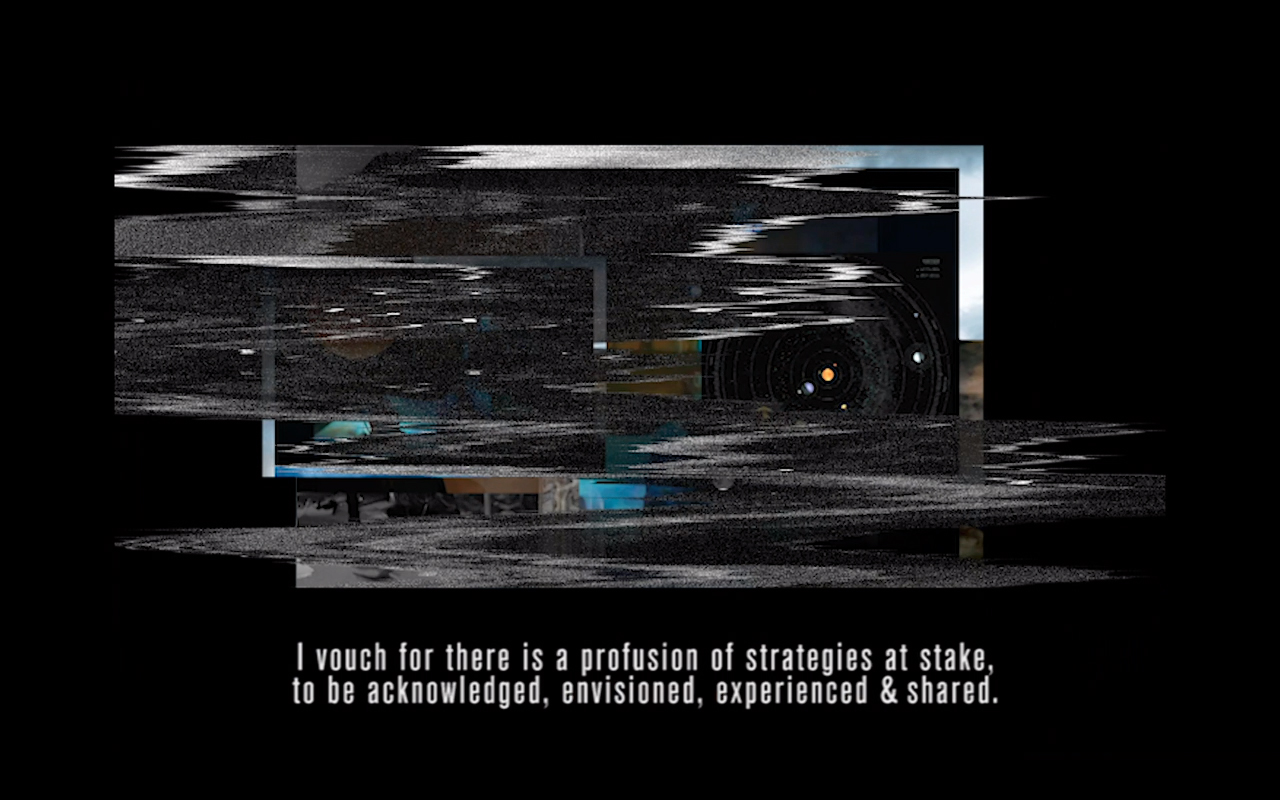
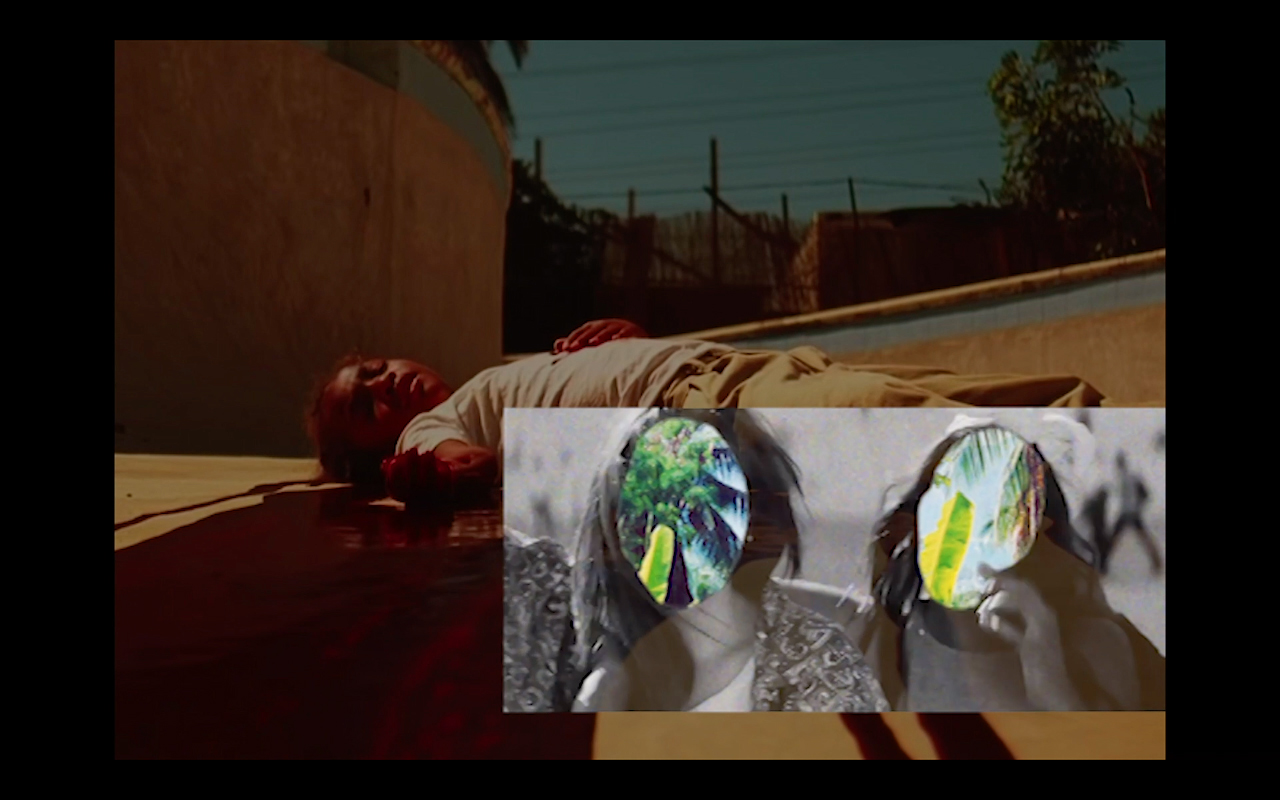
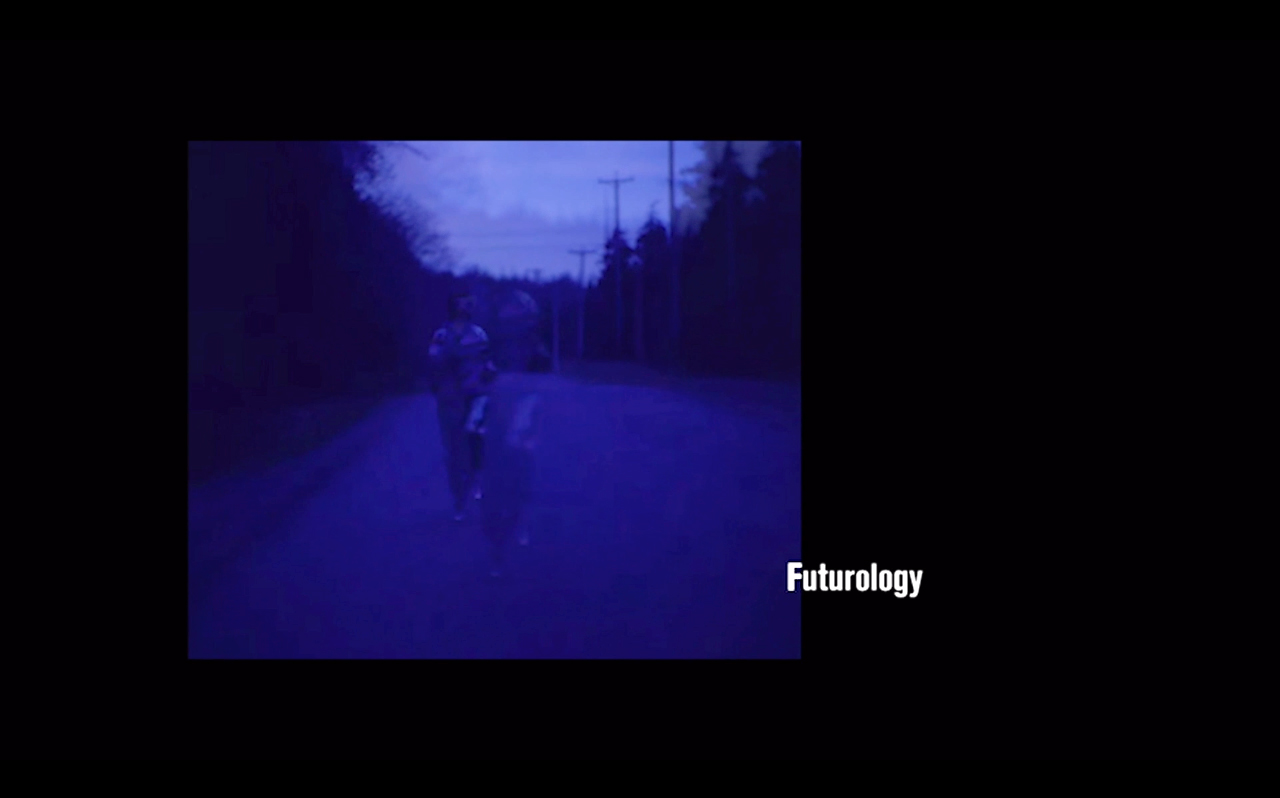
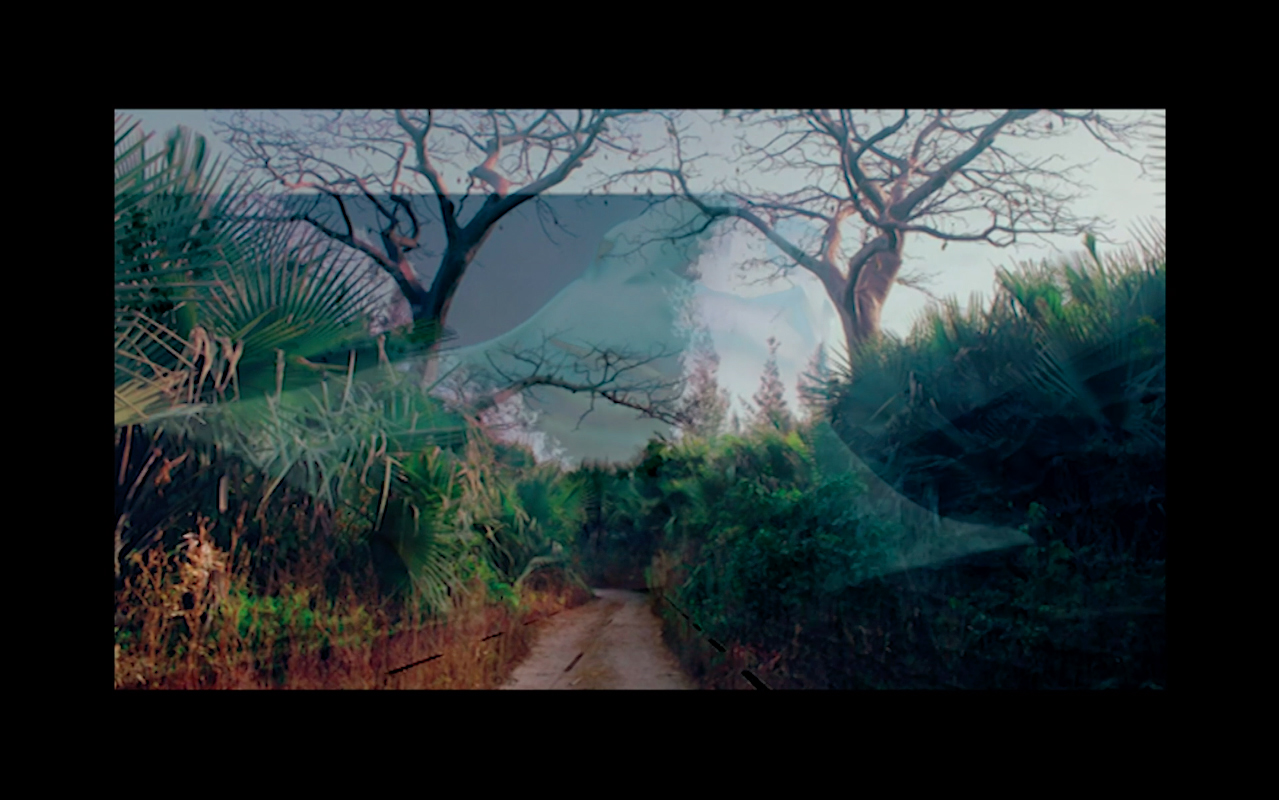

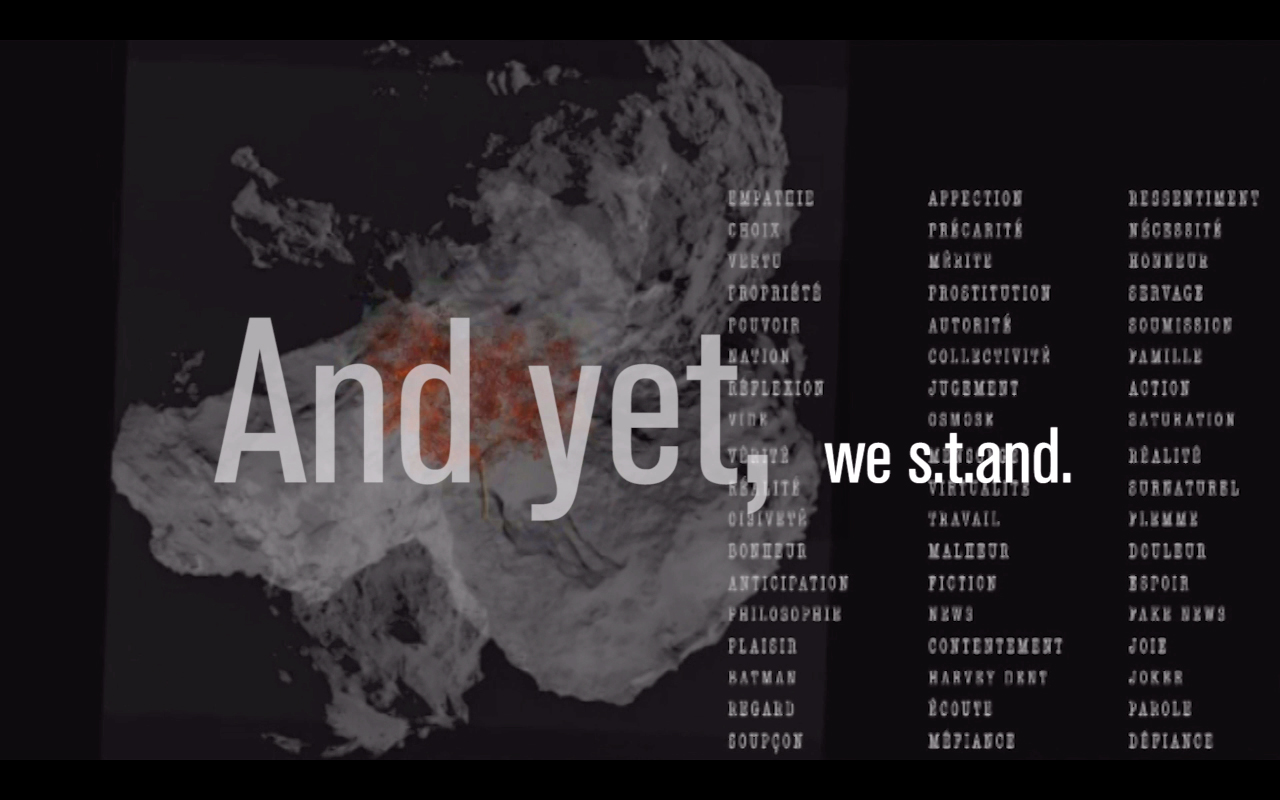
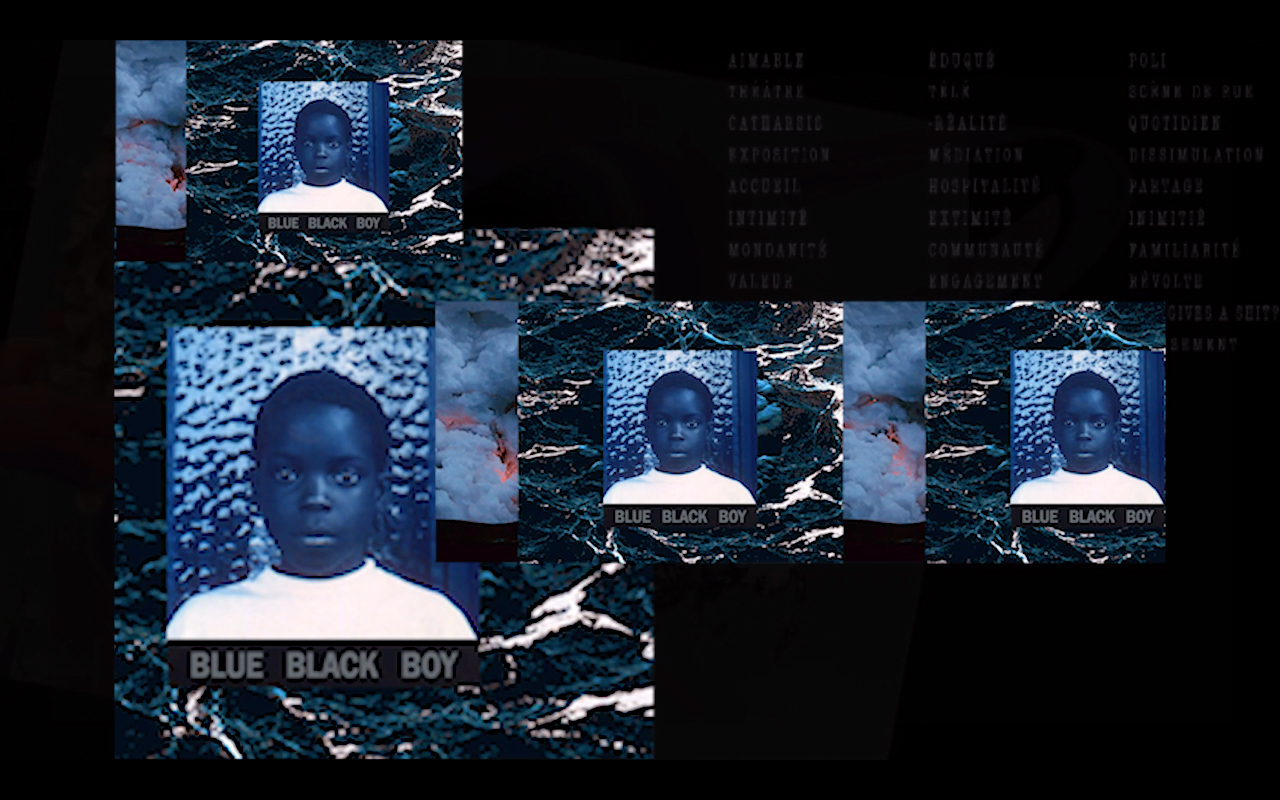
Collapsin’ Trinidad, 2019
Single channel version, 17,22 mns
Film Direction, Editing and Script.
–– Screenings: Laboratoire-BX (Bordeaux, 2019) ; Beursschouwburg (Brussels, 2025)
Collapsin’ Trinidad is a montage of collages, interweaving the voices, personae, and landscapes of three lecture-performances I still intend to complete: S.T.AND, to the Jungle, and Puzzl-ing. Developed over nearly a year (from Fall 2018 to late Summer 2019), this first iteration of the triptych functioned as a bandage-manifesto—a way to dress yet another wound opened by ordinary racism (in Switzerland, France, Belgium, Canada… and, frankly, wherever I traveled this years in particular). #arthustling. And yet, against this — at the scale of the Whole-World of Edouard Glissant — I tried to lay the groundwork for a resistance that is at once solitary and solidarious, paradoxical and luxuriant, heterotopic and biting.
The spaces I navigate — from contemporary art to academic research — are obviously not exempt from discriminatory logics of preservation; nor are their actors spared from postures and sayings that veer from fetishistic at best to deadly at worst. But it is precisely because I/you/they/we remain, bearing and supporting the irony of a world whose capital cannot circulate without us that I need to speak of lineage and of friendship. Of some of those survival strategies — Afrofuturist, speculative, futurible — that transfigure the very images that haunt (and are haunted by) us, from pain to rebirth.
Collapsin’ Trinidad, 2019
Single channel version, 17,22 mns
Film Direction, Editing and Script.
–– Screenings: Laboratoire-BX (Bordeaux, 2019) ; Beursschouwburg (Brussels, 2025)
Collapsin’ Trinidad is a montage of collages, interweaving the voices, personae, and landscapes of three lecture-performances I still intend to complete: S.T.AND, to the Jungle, and Puzzl-ing. Developed over nearly a year (from Fall 2018 to late Summer 2019), this first iteration of the triptych functioned as a bandage-manifesto—a way to dress yet another wound opened by ordinary racism (in Switzerland, France, Belgium, Canada… and, frankly, wherever I traveled this years in particular). #arthustling. And yet, against this — at the scale of the Whole-World of Edouard Glissant — I tried to lay the groundwork for a resistance that is at once solitary and solidarious, paradoxical and luxuriant, heterotopic and biting.
The spaces I navigate — from contemporary art to academic research — are obviously not exempt from discriminatory logics of preservation; nor are their actors spared from postures and sayings that veer from fetishistic at best to deadly at worst. But it is precisely because I/you/they/we remain, bearing and supporting the irony of a world whose capital cannot circulate without us that I need to speak of lineage and of friendship. Of some of those survival strategies — Afrofuturist, speculative, futurible — that transfigure the very images that haunt (and are haunted by) us, from pain to rebirth.
Credits:
–– With video stills from:
Moor Mother - By The Light (dir. Patrick JF Smith)
Céline Sciamma – Bande de filles (2014)
Flying Lotus - Until The Quiet Comes (short film by Kahlil Joseph)
Charles Kinsey’s abusive arrest (leading to his death) witness video
Kelsey Lu - Shades of Blue (dir. Vincent Haycock)
Kelsey Lu - Due West (dir. Cara Stricker & Mindy Le Brock)
Carrie Mae Weems – Blue Black Boy (1997)
–– With video stills from:
Moor Mother - By The Light (dir. Patrick JF Smith)
Céline Sciamma – Bande de filles (2014)
Flying Lotus - Until The Quiet Comes (short film by Kahlil Joseph)
Charles Kinsey’s abusive arrest (leading to his death) witness video
Kelsey Lu - Shades of Blue (dir. Vincent Haycock)
Kelsey Lu - Due West (dir. Cara Stricker & Mindy Le Brock)
Carrie Mae Weems – Blue Black Boy (1997)
––––––––––––––––





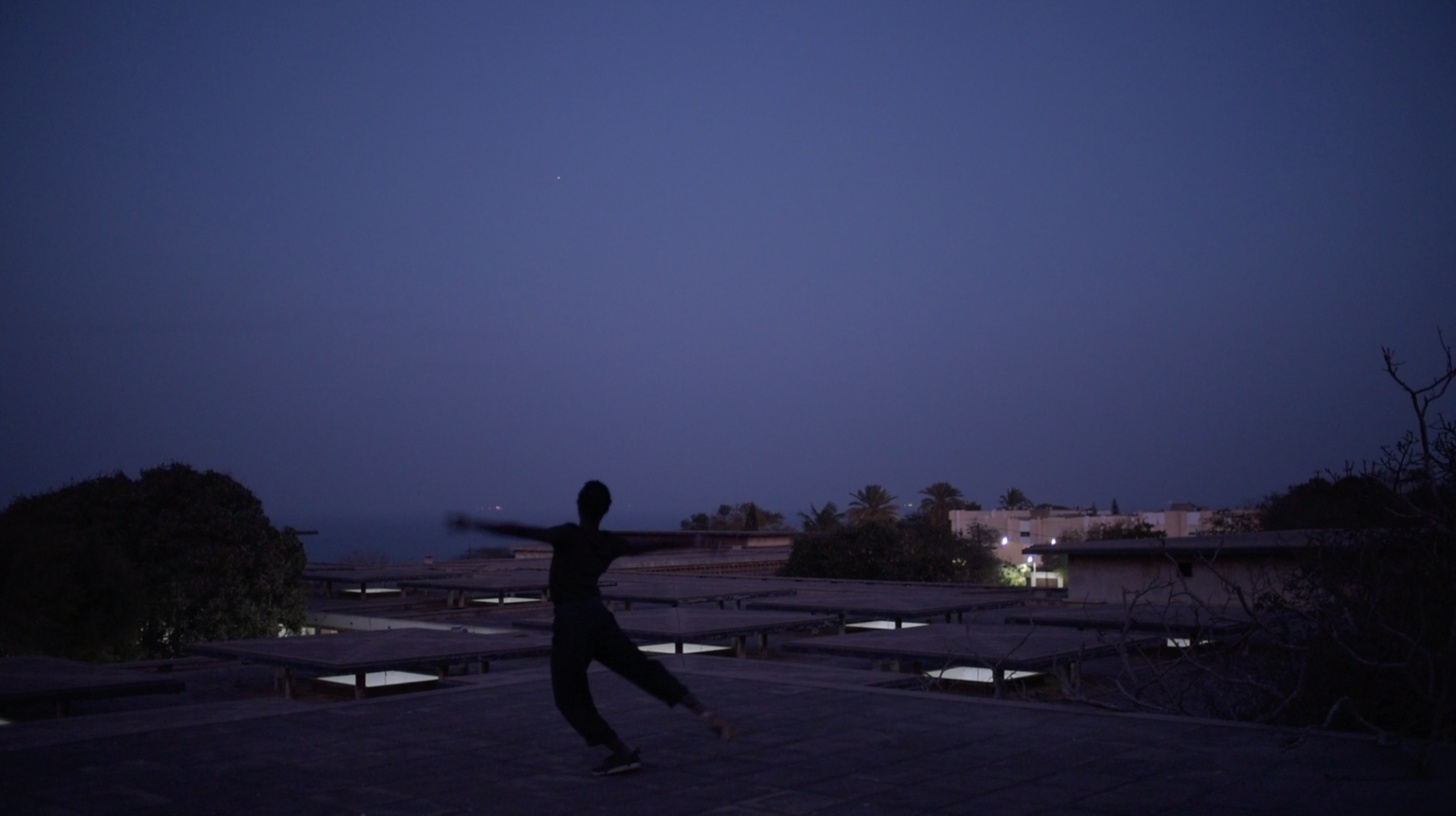
D’HLM à Pikine, 2018
Single-channel video, 7mns
Film Direction, Editing and Performance.
Single-channel video, 7mns
Film Direction, Editing and Performance.
–– Screenings: arc en rêve centre d’architecture (Bordeaux, 2021), African Futures Institute (Accra, 2022)
D’HLM à Pikine is what remains of a break-in — in the rooms and on the unrehabilitated rooftops of Dakar’s former House of Justice, at Cap du Plateau, in 2018 — during the Biennale. As a way to explore the material and immaterial traces of a suspended justice, this intervention took the form of a choreographic interaction where the site was no longer a mere container but an active agent in our practices of in.hospitality. While the ground floor of the imposing building had been renovated to host L’Heure rouge (title to the city’s international Art biennale) — celebrating with great pomp “the decisive moment, [the] pivotal point that concentrates all that led to it, and all that will follow” — we moved through abandoned upper floors, climbing toward the rooftop where we gathered, in silence, with the night. The hour is red, they say. And the night falls.
In this saturated space — filled with artworks, rubble, unresolved case files, forgotten ID photos — and with words withheld, dance and its live capture became a gesture of care. Humble, but necessary. A curation without grandeur, even unofficial, in honor of those who, despite supposed rehabilitation — or even a position of elevation, like those high, cheap seats offered to the poor in Italian-style theaters — remain invisible to the eyes that count (and discount). Presences so discreet they are too often mistaken for absence, and an outstretched hand to renew the bandage. A collage. Not a demiurgic act of healing, but a gesture made in full awareness of contamination. To manipulate, yes — but only with the risk of being touched in (re)turn, to remain in touch.
D’HLM à Pikine is what remains of a break-in — in the rooms and on the unrehabilitated rooftops of Dakar’s former House of Justice, at Cap du Plateau, in 2018 — during the Biennale. As a way to explore the material and immaterial traces of a suspended justice, this intervention took the form of a choreographic interaction where the site was no longer a mere container but an active agent in our practices of in.hospitality. While the ground floor of the imposing building had been renovated to host L’Heure rouge (title to the city’s international Art biennale) — celebrating with great pomp “the decisive moment, [the] pivotal point that concentrates all that led to it, and all that will follow” — we moved through abandoned upper floors, climbing toward the rooftop where we gathered, in silence, with the night. The hour is red, they say. And the night falls.
In this saturated space — filled with artworks, rubble, unresolved case files, forgotten ID photos — and with words withheld, dance and its live capture became a gesture of care. Humble, but necessary. A curation without grandeur, even unofficial, in honor of those who, despite supposed rehabilitation — or even a position of elevation, like those high, cheap seats offered to the poor in Italian-style theaters — remain invisible to the eyes that count (and discount). Presences so discreet they are too often mistaken for absence, and an outstretched hand to renew the bandage. A collage. Not a demiurgic act of healing, but a gesture made in full awareness of contamination. To manipulate, yes — but only with the risk of being touched in (re)turn, to remain in touch.
Credits:
–– Dance / Editing:
Mawena Yehouessi
Images:
Jean-Baptiste Joire
Direction:
Jean-Baptiste Joire, Fallon Mayanja, Mawena Yehouessi
Music:
“Universe”, by Aquarius Heaven
–– Dance / Editing:
Mawena Yehouessi
Images:
Jean-Baptiste Joire
Direction:
Jean-Baptiste Joire, Fallon Mayanja, Mawena Yehouessi
Music:
“Universe”, by Aquarius Heaven
––––––––––––––––
NSNAMDLM, 2023
![]()
![]()
![]()
![]()
![]()
––––––––––––––––
––––––––––––––––
NSNAMDLM, 2023
Choreographic Installation and Immersive Play
–– With: Juan Ferrari, Fallon Mayanja, Esther Meunier Corfdyr, Nicolas Pirus, Sandar Tun Tun and Mawena Yehouessi
–– Venues: Tanzhaus Zürich (2023)
NSNAMDLM (We Were Born In The Middle Of The Sea, in French) is a collective research that gave rise to a multimedia installation and immersive choreographic piece. Shaped around certain “stories of water between us,” — between encounter and exoticism, displacement and display, mobilization and extraction, liquid liberalism and solidarian fluidity — the project does not explore, but implores: a drifting (or precisely a drive, à la Patrick Chamoiseau) through the matrix entanglements of bodies, waters, and diasporic narratives. “We” thus become a kaleidoscopic yet radical conglomerate: the performers and co-authors (incl. Ndoho Ange at various stages), but also technicians, institutions, audiences — and, most crucially, the many aqueous entities, species, and peoples marked, stirred, or saturated by water, whether visible, imagined, denied, or occulted.
What other elements, if not the sea and waters, most truly bind us to one*another — whether we attend to their amniotic, hypnotic, or simply nourishing dimensions? At the same time, are they not also the terrain of crucial geopolitical stakes, directly entangled with strategies of mobilizing and appropriating resources as well as bodies? Hence, NSNAMDLM does not merely invite on contesting the Anthropocene and exiting antagonistic categories of human / non-human. Rather, it engages and incites us to negotiate, mutualize, and (re)potentialize our strange(r) desires — whatever our natures, forms, genders, histories, or identities.
In sum, NSNAMDLM is a platform for co-composing a polyphonic score at the crossings of a plurality of communities, commitments, practices, skills, myths, and solidarities — a matrix able to impregnate / upend performers and publics across all their senses: visual, auditory, proprioceptive, affective, and collective. It is a platform for somatic, poetic, and political experimentation.
Credits: Dramaturgical advisor: Marc Streit; Light: David Baumgartner; Coproduction: Tanzhaus Zürich, Theater Neumarkt; Supported by: City of Zurich Culture, City of Geneve, Villa Arson (France), Ernst Göhner Stiftung
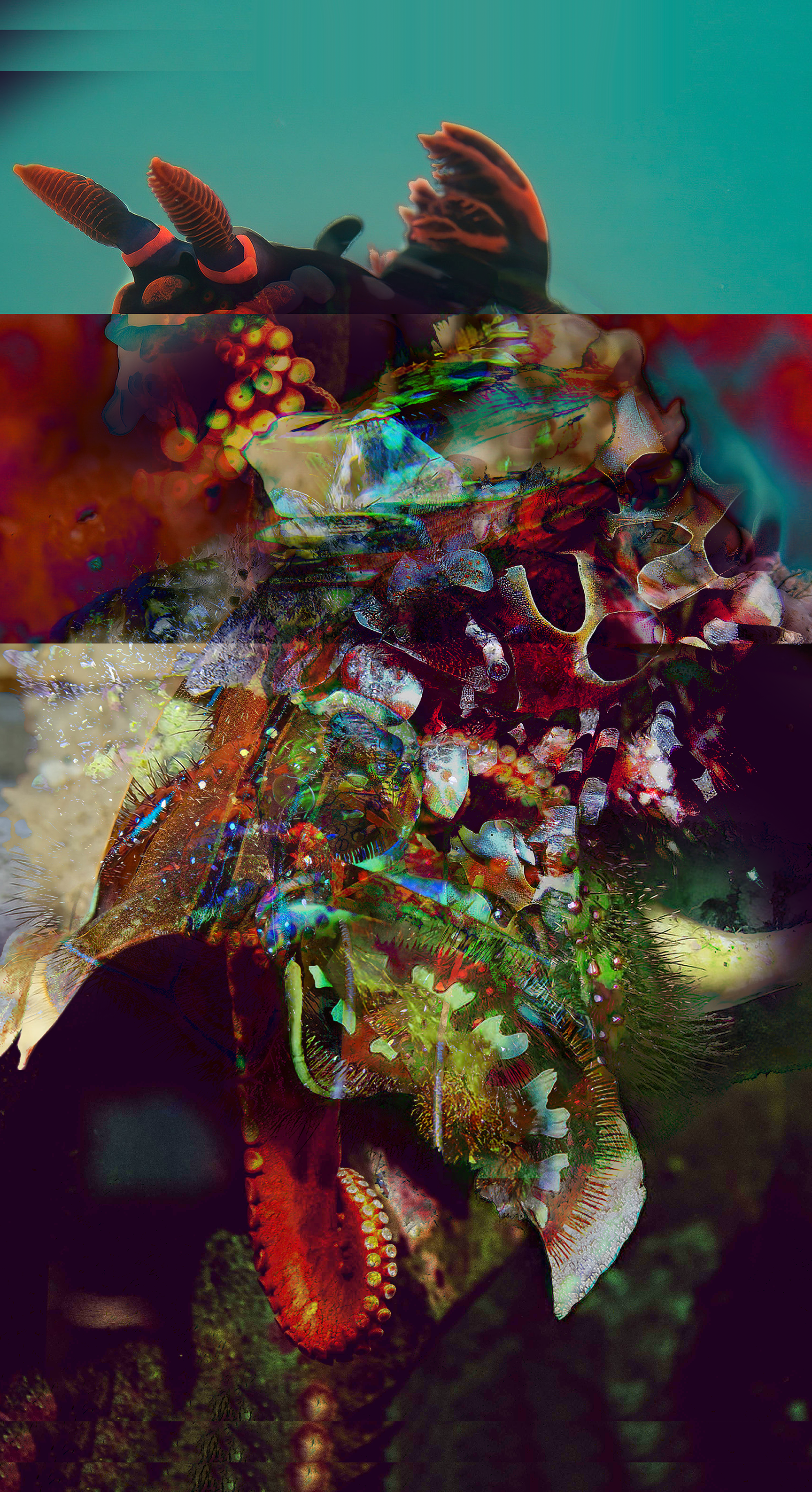


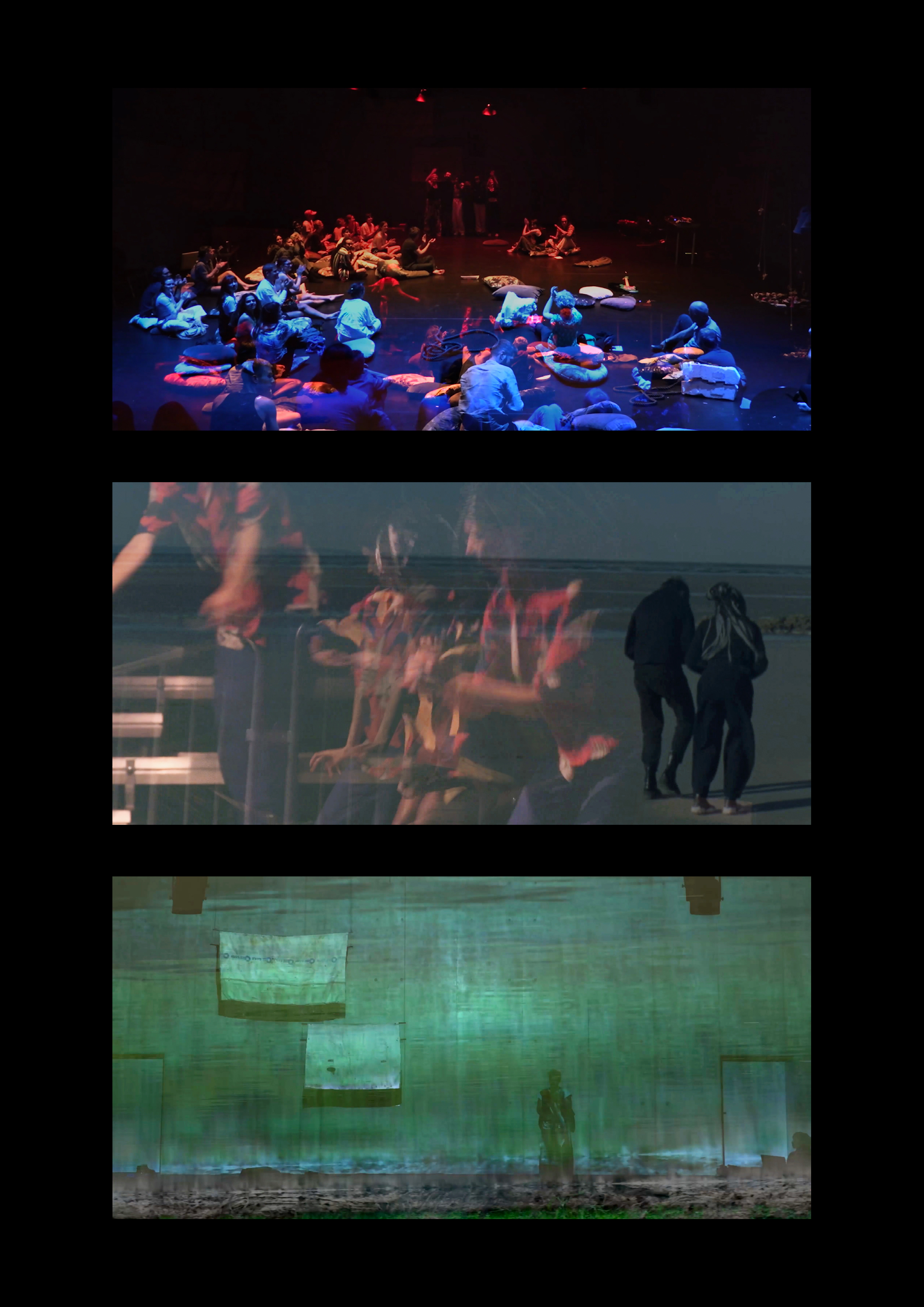

––––––––––––––––
S.T.AND, 2019
Sound installation, spoken word and video
Sound installation, spoken word and video
–– Venues: La Box (Bourges, 2019), Doc! (Paris, 2019), Cipm (Marseille, 2019)
S.T.AND is a performance shaped by anxiety, fatigue, and disarray — a space where White(ness) reveals itself not as a colour or a burden, but as fact: an implacable system of settle- and entitle-ment. Facing it: the fragile fantasy of community, stitched together by a romantic understanding of revolt, inhabited paradoxes, and the specter of dis.embodied resistance — a longing that (inescapably) translates into shared dis.obedience. In-between: Black(ness) is standing. Strained yet acerbically vivacious, ghosting refusal and resurgence alike. Yet, this ain’t about reasserting the binary of White vs Black. Their equivalence isn’t reaffirmed, but reentered — as a structural script whose repetition exposes both its cost and its fallacies. No standing in, or out, but a cut through the road. A grain of sand in the wheel, a sea of sand once the mountain has crumbled.
S.T.AND is a performance shaped by anxiety, fatigue, and disarray — a space where White(ness) reveals itself not as a colour or a burden, but as fact: an implacable system of settle- and entitle-ment. Facing it: the fragile fantasy of community, stitched together by a romantic understanding of revolt, inhabited paradoxes, and the specter of dis.embodied resistance — a longing that (inescapably) translates into shared dis.obedience. In-between: Black(ness) is standing. Strained yet acerbically vivacious, ghosting refusal and resurgence alike. Yet, this ain’t about reasserting the binary of White vs Black. Their equivalence isn’t reaffirmed, but reentered — as a structural script whose repetition exposes both its cost and its fallacies. No standing in, or out, but a cut through the road. A grain of sand in the wheel, a sea of sand once the mountain has crumbled.
––––––––––––––––
MÉTA, 2018
Sound installation, reading and video
Sound installation, reading and video
–– Venues: Point Culture Bruxelles (2018), Montévidéo (Marseille, 2018), La Gaîté Lyrique (Paris, 2018)
MÉTA gathers three personas: Mawena, M.Y, and a rhizome entity. In search — (of) each other, of a common self, or at least an intersection in tune — as a situated body, a device (or a projected image), and a symbiotic reality. Working through the tension between speculative fiction, subjective dissociation, and critical relational strategies, MÉTA becomes a quest for a third path: impersonal yet intimate, distributed, infra-verbal and perhaps collective, non-human, post-identitarian — a mode of being without fixity, a portraiture of ties over traits. Because in this looping entanglement, they do eventually stumble upon a shared score: that of an (All-)against. Not a unison, but a discordant accord — scattered, syncopated, and necessarily unresolved. A partition not of harmony, but of proximity. Not the Tout-monde, but the Tout-contre — close-against each other, without dissolving.
MÉTA gathers three personas: Mawena, M.Y, and a rhizome entity. In search — (of) each other, of a common self, or at least an intersection in tune — as a situated body, a device (or a projected image), and a symbiotic reality. Working through the tension between speculative fiction, subjective dissociation, and critical relational strategies, MÉTA becomes a quest for a third path: impersonal yet intimate, distributed, infra-verbal and perhaps collective, non-human, post-identitarian — a mode of being without fixity, a portraiture of ties over traits. Because in this looping entanglement, they do eventually stumble upon a shared score: that of an (All-)against. Not a unison, but a discordant accord — scattered, syncopated, and necessarily unresolved. A partition not of harmony, but of proximity. Not the Tout-monde, but the Tout-contre — close-against each other, without dissolving.